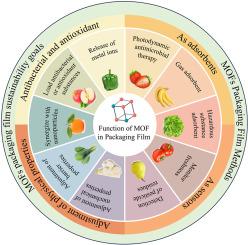Recent Developments in Synthesis, Functionality, and Sustainability of Metal-Organic Framework Films for Fruits and Vegetables Packaging
IF 15.4
1区 农林科学
Q1 FOOD SCIENCE & TECHNOLOGY
引用次数: 0
Abstract
Background
Metal-organic frameworks (MOFs), with their tunable porosity and high surface area, have emerged as promising materials for improving packaging films designed to preserve the quality and extend the shelf life of fresh produce.
Scope and approach
This review examines eight strategies for synthesizing MOF-based films, namely, electrodeposition, dip-coating, layer-by-layer self-assembly, in situ synthesis, electrospinning, spray drying, mixed-ligand, and template-assisted methods, providing comparative insights into their applications. It further summarizes the recent progress in the functional performance of these films in maintaining quality and prolonging shelf life of fresh fruits and vegetables. Finally, this review emphasizes the sustainable scalability of MOF films and highlights promising directions for their prospective applications.
Key findings and conclusions
MOFs function as antibacterial agents through multiple mechanisms, including metal ion release, photodynamic antibacterial activity, and synergistic interactions with nanoparticles. In addition, MOFs serve as carriers for natural antibacterial compounds and antioxidants, enhancing their stability and enabling controlled release. MOFs contribute to the regulation of barrier and mechanical properties of packaging films. These MOF films can adsorb ethylene and deleterious gases, monitor fruits and vegetables freshness in real time, and detect pesticide residues. The choice of MOF film synthesis method is influenced by cost, scalability, film quality, and substrate compatibility. Their commercialization warrants exploration of environmental sustainability, economic feasibility, chemical safety, regulatory compliance, and consumer acceptance. This review provides insights into green synthesis strategies and process optimization, thereby offering prospects for industrial application of MOF-based films.

水果和蔬菜包装用金属有机框架膜的合成、功能和可持续性研究进展
金属有机框架(mof)具有可调节的孔隙率和高表面积,已成为改善包装薄膜的有前途的材料,旨在保持新鲜农产品的质量和延长保质期。本文综述了电沉积法、浸渍法、逐层自组装法、原位合成法、静电纺丝法、喷雾干燥法、混合配体法和模板辅助法等八种制备mof基薄膜的方法,并对它们的应用进行了比较。综述了近年来这些薄膜在保鲜果蔬品质和延长货架期方面的研究进展。最后,本文强调了MOF薄膜的可持续可扩展性,并指出了其未来应用的前景。smofs作为抗菌药物的作用机制多种多样,包括金属离子释放、光动力抗菌活性以及与纳米颗粒的协同作用。此外,mof还可以作为天然抗菌化合物和抗氧化剂的载体,增强其稳定性并实现控释。mof对包装薄膜的阻隔性和力学性能起着调节作用。这些MOF薄膜可以吸附乙烯和有害气体,实时监测水果和蔬菜的新鲜度,并检测农药残留。MOF薄膜合成方法的选择受成本、可扩展性、薄膜质量和衬底相容性等因素的影响。它们的商业化需要探索环境可持续性、经济可行性、化学品安全性、法规遵从性和消费者接受度。本文综述了mof基薄膜的绿色合成策略和工艺优化,展望了mof基薄膜的工业应用前景。
本文章由计算机程序翻译,如有差异,请以英文原文为准。
求助全文
约1分钟内获得全文
求助全文
来源期刊

Trends in Food Science & Technology
工程技术-食品科技
CiteScore
32.50
自引率
2.60%
发文量
322
审稿时长
37 days
期刊介绍:
Trends in Food Science & Technology is a prestigious international journal that specializes in peer-reviewed articles covering the latest advancements in technology, food science, and human nutrition. It serves as a bridge between specialized primary journals and general trade magazines, providing readable and scientifically rigorous reviews and commentaries on current research developments and their potential applications in the food industry.
Unlike traditional journals, Trends in Food Science & Technology does not publish original research papers. Instead, it focuses on critical and comprehensive reviews to offer valuable insights for professionals in the field. By bringing together cutting-edge research and industry applications, this journal plays a vital role in disseminating knowledge and facilitating advancements in the food science and technology sector.
 求助内容:
求助内容: 应助结果提醒方式:
应助结果提醒方式:


